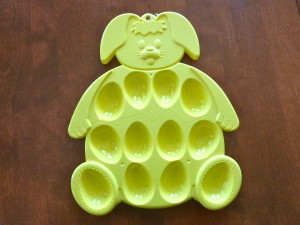Egg Tray For Adding/Subtracting/Multiplying/Dividing
Ok, so Easter is done but I have one more idea for how to use something you may have…an egg tray (you could also use an egg carton or ice-cube tray).

I got this bunny shaped Egg Tray at Target last year and thought it would be perfect not only for drying the eggs after they have been colored but they would be a great math organizer for adding and subtracting up to 12. For these, I would use dice, playing cards or flash cards to come up with the numbers to add or subtract. (Previous Post on Easy Math Organizers)
Recently though, my mind has been thinking about introducing multiplication and division to Andrew. He found a “Brain Age†game on his DS and was asking what some of the multiplication and division equations meant. It’s time for me to introduce these concepts to him and as with any new concept, I want to begin by making it very concrete, using items that he can manipulate to help connect the abstract numbers and symbols with what they actually mean.
My Obstacle Course Station Activity: Making Groups Of Marshmallows (Introducing Multiplication)


I introduced this to him using dice that went up to 8 and while he did okay with it, the next time I will tweak it and make some flash cards to build understanding of one common factor instead of having it be so random. The flash cards I will make will start with common factor of 1 – 1×1, 2×1, 3×1, 4×1, etc., so that he begins understanding the “groups of” concept. We will build from there perhaps throwing in some previously mastered facts to reinforce his knowledge.
Building Understanding For Multiplication And Division
“Mom, we’re finally learning multiplication so I have to memorize all of these facts by tomorrow!” Ahhh…at first they are so excited, as though they’ve reached an important rite of passage. True, there are some children who are able to do this right away and “get” what the numbers represent without needing it broken down. Others are able to memorize the equations but lack the understanding of what they actually represent. This becomes obvious when story problems become difficult because they don’t quite understand what the question is needing them to do – add, subtract, multiply or divide. Then there are those who cannot seem to memorize them and have no tools to help them figure out what they are supposed to be doing.
I prefer to approach abstract concepts by encouraging everyone to begin with a firm understanding of what the concept means, what it looks like and how to “act it out†with manipulatives. This includes those who get it right away because it’s interesting to see how they approach it through actions. Many times they will bristle at this notion – Why do I have to do this? I already know it!”  This is good practice for working on explaining their methods and showing others about how they see things.
My last few years of teaching, we really emphasized to our students the importance of being able to show what they are doing through numbers, words and pictures (those of you who are familiar with the “Investigations†math series will recognize this.). Using a math organizer along with manipulatives replaces the “picture†making because your child is actually representing the equation with items. Their work IS the picture. This will give you immediate information on where your child is with regards to understanding what the symbols mean.
Building Multiplication Skills:
A multiplication sentence may read 4 x 3 = 12 to you, but when teaching my students, I emphasized that it really means 4 “groups of†3 equals 12. It also represents 3+3+3+3=12 since multiplication is repeated addition.
Building Division Skills:
The same is true for division. 12/4=3 means 12 divided into 4 groups which gives you 3 in each group. When working on division, an organizer can really help your child grasp this concept. Being able to actually divide a given number into groups that must have the same amount.
Make It Relevant
To do this, I always found it helpful to connect it with food or money. Ex. For 12 divided by 4, I would tell them that they have 12 jelly beans that they have to pass out evenly to their 4 friends. How many jelly beans does each person get? They can do the “one for me, one for you, one for you†method until they have all been passed out, giving each person 3 jelly beans.
Using manipulatives, or items to count, when children are first learning math concepts can help them fully understand what they are doing, allows them to see what it looks like and connect that with the numeral representation of it.
Engage, Encourage and Empower!